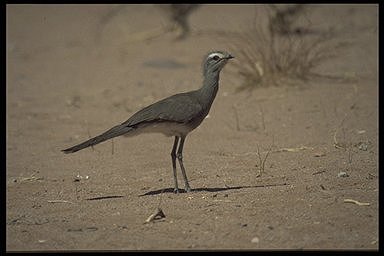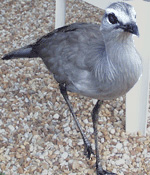
Chunga burmeisteri
TAXONOMY
Dicholophus burmeisteri Hartlaub, 1860, Argentina.
OTHER COMMON NAMES
English: Lesser seriema, Burmeister’s seriema; French:
Cariama de Burmeister; German: SchwarzfuЯseriema; Spanish:
Chuсa Patinegra.
PHYSICAL CHARACTERISTICS
Sexes similar. Blackish legs and bill, red iris, two broad black
bars before a narrowly tipped tail. Frontal feathers are hair-like
at the tip, but frontal crest is not distinctive. Juveniles are similar
to adults, but with distinct barring of the head, foreneck
and breast, and white spots along the back and wing coverts.
DISTRIBUTION
East and southeast Bolivia, Paraguay, northwest Argentina.
HABITAT
Lowland open, dry wooded areas, grasslands, and thorny scrub.
BEHAVIOR
More sedentary than red-legged seriema. Unable to distinguish
between venomous and nonvenomous snakes, which can lead
to a birds death. Call is loud yelping and has been compared to
that of a yelping puppy. Call can be heard several miles away
and is usually given early in the morning, most often to define
territory between pairs and is often heard as a duet between
the two birds.
FEEDING ECOLOGY AND DIET
Omnivorous diet including snakes, lizards, frogs, birds, small
vertebrates, insects, fruit, and vegetable matter. May be found
near livestock, eating insects stirred up during passage. Birds
slam large prey on rocks to pulverize. Forages in pairs or small
groups.
REPRODUCTIVE BIOLOGY
Nests are compact, made of sticks, and are built anywhere
from ground level up to 10 ft (3 m) in a tree. Little else is documented
on this species; however, they are likely similar to
red-legged seriema.
CONSERVATION STATUS
Not threatened. Listed as still fairly common in Argentina, but
documentation elsewhere is poor. May be more likely to be
threatened in the future due to the smaller range.
SIGNIFICANCE TO HUMANS
Although egg-collecting and hunting are uncommon, the
species has been hunted by natives of the Paraguayan Chaco.
Farmers also place the species with chickens to signal the
alarm when intruders approach, and to kill snakes.
Other popular Animals
Photo Gallery of - Black-legged seriema




 Animalia Life
Animalia Life